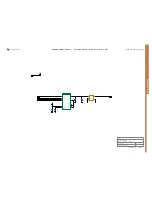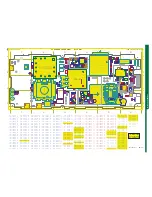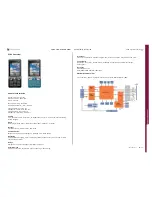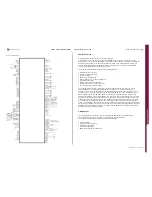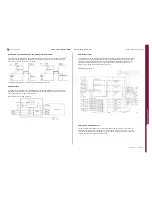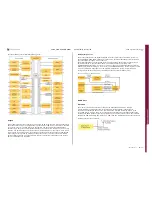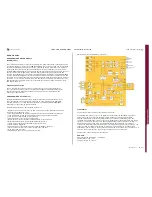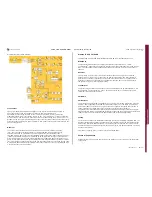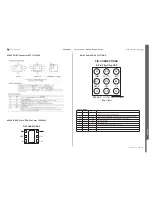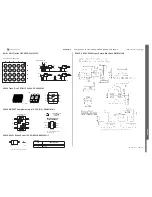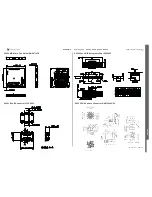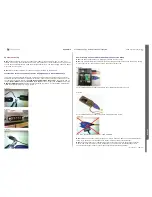
C702
1221-7857 rev. 1
FUNCTIONAL OVERVIEW
FU
N
C
T
IO
N
A
L O
V
E
R
V
IE
W
FU
N
C
T
IO
N
A
L O
V
E
R
V
IE
W
Technical Description
FUNCTIONAL OVERVIEW
FU
N
C
T
IO
N
A
L O
V
E
R
V
IE
W
FUNCTIONAL OVERVIEW
FU
N
C
T
IO
N
A
L O
V
E
R
V
IE
W
System connector (X2300) pin out:
Clocks
Clock Distribution
The clocking for the access and application subsystems is separated. This means that they can
wake up or go to sleep mode independently. The access subsystem is clocked by the 26 MHz
Voltage Controlled Crystal Oscillator B1100 (VCXO) located in the Thor Radio Module (N1200).
When the access subsystem has a job to do, the Master Clock (MCLK) signal is requested from
the RF part. Most other clocks needed within the access subsystem are generated from the
MCLK. Some minor parts like sleep timer and cable detect use the 32 kHz real-time clock. The
32 kHz real-time clock clocks the application subsystem, and all other internal clocks needed
within the application subsystem are generated from this clock. However, when audio is
transferred between the application and the access subsystems, the MCLK is used.
Master Clock
(26 MHz)
The 26.00 MHz VCXO-based MCLK is distributed as a square wave signal from the N1001 inside
the Thor Radio Module (GSM/GPRS/EDGE). In order to have full control over the load on the
MCLK, only the access side of the digital baseband controller is allowed to request the MCLK.
However, by indirect means also the application side CPU can issue the request. A VCXO-based
square wave (WBCLK) is also distributed to the Squid Radio Module (WCDMA), but is turned on
only upon a command from the digital baseband controller.
Real-time Clock
(32. 768 KHz)
A 32.768 kHz crystal oscillator (B2101) provides a low frequency clock whenever the phone
has power. This clock is used to keep the Real-Time Clock (RTC) block functioning, so that
the phone can keep track of the time and date. The low frequency clock is generated in the
analog baseband controller N2000 (Vera) and distributed to the digital baseband controller
D2000 (Anja), and if necessary to external devices like Bluetooth, FM radio and A-GPS.
A-GPS
The Assisted GPS functionality in the phone is realized with the Global Locate Hammerhead GPS
module. The Global Locate Hammerhead belongs to the Type 2 GPS solutions.
Clock Reference Frequency
The A-GPS module is using two reference frequencies, a 32.768 kHz clock (RTCCLK) from the
N2000 (Vera), and a 26 MHz reference clock (SYSCLK) from the D2000 (Anja). The RTCCLK is
used for the real time clock function. The RTCCLK is distributed to the A-GPS module (N1430)
as a logical square wave. SYSCLK is derived from the reference modulation clock MCLK from
the access system and is distributed from the D2000 (Anja) to the A-GPS module (N1430).
This 26 MHz clock is synchronized with the cellular network to an accuracy of ±0.1 ppm.
SYSCLK does not however provide an absolute reference to 26 MHz. Owing to the effects of
Doppler under normal (extreme) operational conditions, the absolute accuracy of the cellular
reference cannot be guaranteed better than ±0.5 ppm. Automatic frequency updates can also
cause large frequency corrections, with associated phase discontinuities. In order to isolate the
A-GPS module for the unstable effects of SYSCLK, an external reference clock is required. This
external reference frequency provided by a TCXO (B1430) is required to provide a clock with
very high short term stability. The frequency of the TCXO (B1430) is calibrated against the
cellular reference clock by the A-GPS module enabling the use of a more economical less
accurate TCXO (B1430).
Interface and Control
The Interface and control consists of system timing and control. The control interface includes a
communication link where both data and control information are transferred between the
platform and the A-GPS module. Data and command information is transferred using a full-
duplex Universal Asynchronous Receiver Transmitter (UART) interface.
Other control signals include the following:
• A GPIO reset used as a reset signal (nRESET) to the GPS module.
• A Transmission On signal (TXON/ RX_HOLD), is used to indicate to the A-GPS module when
the phone is transmitting. The A-GPS modules receiver is disabled whilst the phone is
transmitting.
• A hardware timing pulse (SYNC) providing the A-GPS module with a highly accurate timing
reference. The A-GPS is able to accurately synchronize its GPS time to this reference pulse.
• A GPIO used as an enable (POWERON) signal to the GPS module.
• A GPIO used for power control for the GPS module.
A-GPS Block Diagram:
SEMC Troubleshooting Manual
94
(115)
Summary of Contents for C702
Page 116: ...www s manuals com ...


